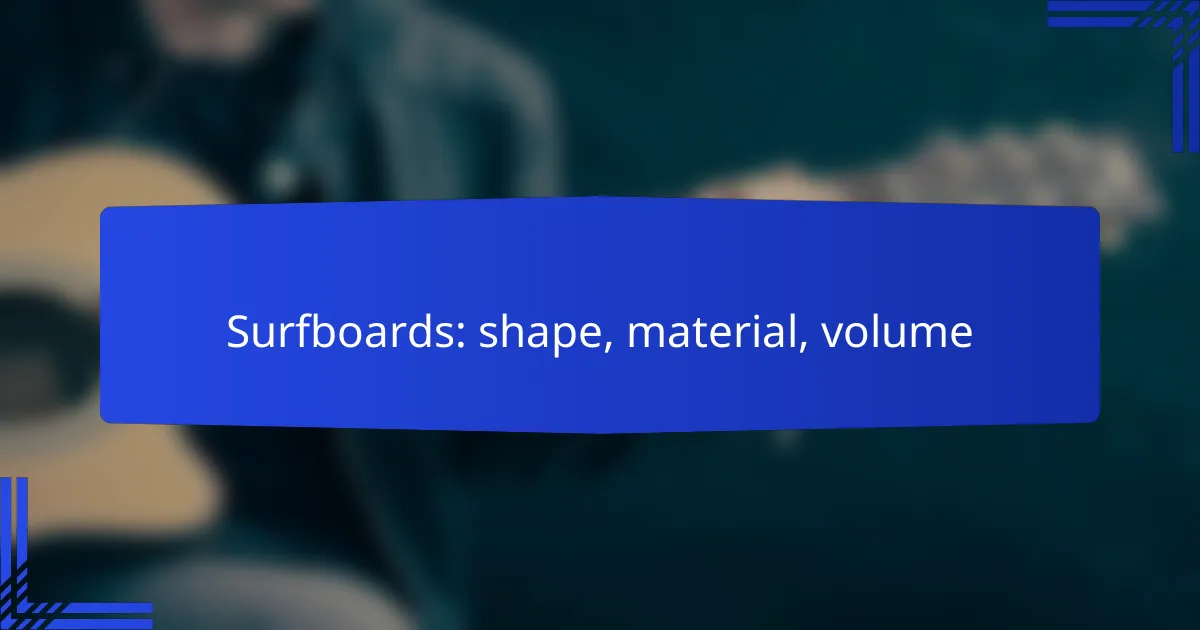Surfboards come in various shapes, materials, and volumes, each tailored to enhance performance in New Zealand’s diverse surf conditions. From shortboards to longboards, the shape of a surfboard can significantly impact how well a surfer can navigate different wave types. The choice of material also plays a crucial role, affecting weight and responsiveness, while the ideal volume is determined by the surfer’s weight and skill level, ensuring optimal stability and maneuverability.

What surfboard shapes are best for New Zealand waves?
New Zealand’s diverse surf conditions call for a variety of surfboard shapes to maximize performance. Depending on the wave type and surfer skill level, options like shortboards, longboards, fish shapes, and funboards each offer unique advantages.
Shortboards for performance
Shortboards are designed for high performance, making them ideal for experienced surfers tackling powerful waves. Typically ranging from 5’6″ to 6’4″, they feature a narrow profile and a pointed nose, allowing for quick turns and aerial maneuvers.
When choosing a shortboard, consider the wave conditions. They excel in steep, fast waves, which are common in New Zealand’s surf spots. However, beginners may find them challenging due to their reduced stability.
Longboards for stability
Longboards, usually between 8′ and 10′, provide excellent stability, making them suitable for beginners and those looking for a relaxed ride. Their wider shape and rounded nose allow for smooth paddling and easier catching of waves.
In New Zealand, longboards perform well in smaller, mellow waves, where their stability can be fully utilized. They are great for cruising and can be a fun choice for those who enjoy a more laid-back surfing experience.
Fish shapes for maneuverability
Fish-shaped boards are shorter and wider, typically ranging from 5’4″ to 6’2″, and are designed for maneuverability. Their unique shape allows for quick turns and adaptability in various wave conditions, making them a popular choice among intermediate surfers.
These boards work well in smaller, choppy waves often found on New Zealand’s coasts. Their design helps maintain speed and control, allowing surfers to navigate through less-than-ideal conditions effectively.
Funboards for versatility
Funboards are a hybrid between shortboards and longboards, usually measuring between 7′ and 8′. They offer a balance of stability and performance, making them suitable for a wide range of surfers, from beginners to intermediates.
In New Zealand, funboards are versatile enough to handle various wave types, from small beach breaks to larger swells. They are an excellent option for those who want a board that can adapt to different surfing styles and conditions.

How does surfboard material impact performance?
The material of a surfboard significantly influences its performance, affecting factors like weight, durability, and responsiveness. Choosing the right material can enhance your surfing experience by aligning with your skill level and the type of waves you typically ride.
Epoxy for lightweight durability
Epoxy surfboards are known for their lightweight and durable characteristics, making them a popular choice among surfers. They typically weigh less than traditional polyurethane boards, allowing for easier maneuverability and quicker turns.
Additionally, epoxy boards are more resistant to dings and damage, which can prolong their lifespan. This makes them a practical option for surfers who frequently encounter rough conditions or rocky shorelines.
Polyurethane for traditional feel
Polyurethane surfboards offer a classic feel that many surfers prefer, especially those who value a more traditional riding experience. These boards tend to provide a softer flex, which can enhance the connection with the water and improve overall performance.
However, polyurethane boards are generally heavier and less durable than epoxy options. Surfers should consider their skill level and the types of waves they ride when choosing between these materials.
Carbon fiber for advanced responsiveness
Carbon fiber surfboards are engineered for advanced responsiveness, making them ideal for competitive surfers. The material is incredibly stiff yet lightweight, allowing for precise control and quick reactions in dynamic wave conditions.
While carbon fiber boards can be more expensive than other materials, their performance benefits can justify the investment for serious surfers. It’s essential to assess your surfing style and budget before opting for this high-performance option.

What is the ideal volume for surfboards in New Zealand?
The ideal volume for surfboards in New Zealand typically ranges from 30 to 60 liters, depending on the surfer’s weight, skill level, and the type of waves they ride. Beginners often benefit from higher volume boards for stability, while advanced surfers may prefer lower volume for maneuverability.
Volume recommendations for beginners
Beginners should look for surfboards with a volume that is about 40 to 60 liters, as this provides the necessary buoyancy and stability to help them catch waves more easily. A wider and thicker board can enhance paddling efficiency and balance, making it easier to stand up.
For example, a beginner weighing around 70 kg might choose a board with approximately 50 liters of volume. This range allows for a comfortable learning experience while still being manageable for progression.
Volume considerations for advanced surfers
Advanced surfers typically opt for surfboards with lower volume, generally between 30 to 40 liters, to enhance their performance and maneuverability in challenging conditions. This allows for quicker turns and better responsiveness on the wave.
When selecting a board, experienced surfers should consider their weight, skill level, and preferred wave type. For instance, a surfer weighing 80 kg might choose a board with around 35 liters of volume for optimal performance in more dynamic surf conditions.

What factors should you consider when choosing a surfboard?
When choosing a surfboard, consider your skill level, the wave conditions in New Zealand, and your personal preferences. Each factor plays a crucial role in ensuring you select a board that enhances your surfing experience and performance.
Skill level and experience
Your skill level significantly impacts the type of surfboard you should choose. Beginners typically benefit from wider, more stable boards that offer better balance and paddling ease, such as soft-top or funboards. Intermediate and advanced surfers may prefer shorter, more maneuverable boards like shortboards or fish shapes that allow for greater performance and tricks.
As you progress, consider boards with varying volumes and shapes to match your evolving skills. A common mistake is to stick with a board that no longer suits your ability, which can hinder your improvement.
Wave conditions in New Zealand
New Zealand’s diverse wave conditions require careful consideration when selecting a surfboard. For instance, in areas with smaller, mellow waves, a longer board with more volume can help you catch waves easily. Conversely, for more powerful, steep waves, a shorter, thinner board may be more appropriate to handle the speed and maneuverability needed.
Familiarize yourself with local surf spots and their typical conditions to choose a board that performs well in those environments. Local surf shops can provide valuable insights into the best board types for specific locations.
Personal preferences and style
Your personal preferences and surfing style are essential in choosing the right surfboard. Consider factors such as the type of surfing you enjoy—whether it’s cruising, performing tricks, or big wave riding. This will guide you in selecting a board shape and size that complements your style.
Additionally, aesthetics play a role; choose a design and color that resonates with you. Don’t hesitate to test different boards to find the one that feels right, as comfort and confidence on the board can significantly enhance your surfing experience.

How do surfboard shapes affect paddling and wave catching?
Surfboard shapes significantly influence paddling efficiency and wave catching ability. Wider boards provide more stability and ease during paddling, while narrower designs enhance maneuverability for quick turns once on a wave.
Wider shapes for easier paddling
Wider surfboards, often referred to as “funboards” or “longboards,” offer increased surface area, making it easier to paddle and catch waves. This shape allows for better buoyancy, which is particularly beneficial for beginners or those looking to ride smaller waves.
When selecting a wider board, consider a width of around 22 to 24 inches for optimal stability. This added width helps maintain balance while paddling, reducing fatigue and allowing for longer sessions on the water.
Narrow shapes for quicker turns
Narrow surfboards, such as shortboards, are designed for agility and speed, allowing surfers to make quick turns and perform advanced maneuvers. These boards typically range from 18 to 20 inches in width, providing less drag and enabling sharper angles on waves.
While narrow shapes excel in performance, they require more skill to paddle effectively. Surfers should practice their paddling technique to maximize efficiency and maintain speed, especially in challenging conditions. Choosing a narrower board is ideal for those focused on performance rather than stability.

What are the latest trends in surfboard design?
The latest trends in surfboard design focus on sustainability and personalization. Eco-friendly materials are gaining popularity, while custom shapes tailored to individual surfers’ needs enhance performance and comfort.
Eco-friendly materials
Surfboard manufacturers are increasingly using eco-friendly materials to reduce environmental impact. Common alternatives include recycled polystyrene, bio-resins, and sustainably sourced wood. These materials not only decrease carbon footprints but also offer comparable performance to traditional options.
For example, some brands are now offering boards made from plant-based resins that are less harmful to the ocean ecosystem. When selecting a surfboard, look for certifications or labels indicating sustainable practices to ensure you’re making an environmentally conscious choice.
Custom shapes for individual surfers
Custom surfboard shapes are becoming more accessible, allowing surfers to optimize their boards for specific styles and conditions. Factors such as volume, width, and rocker can be tailored to match a surfer’s skill level and preferred wave types. This personalization can significantly enhance performance.
Surfers should consider their weight, height, and surfing style when choosing a custom shape. For instance, a heavier surfer may benefit from a board with more volume for better buoyancy, while a lighter surfer might prefer a narrower shape for increased maneuverability. Consulting with a shaper can help in making informed decisions about the best design for individual needs.

How can you maintain your surfboard’s performance?
To maintain your surfboard’s performance, regular care and upkeep are essential. This includes cleaning, waxing, and proper storage to ensure longevity and optimal functionality.
Regular cleaning and waxing
Cleaning your surfboard after each use helps remove salt, sand, and debris that can damage the surface. Use fresh water and a soft cloth to wipe it down, especially focusing on the fins and tail. Avoid using harsh chemicals that can degrade the materials.
Waxing is crucial for maintaining grip and performance on the water. Apply a fresh layer of surf wax every few sessions, or as needed, depending on water temperature and wear. A well-waxed board enhances your control and reduces the risk of slipping.
Check for any dings or cracks during your cleaning routine. Addressing these issues promptly can prevent further damage and maintain the board’s performance. Use a repair kit for minor repairs or consult a professional for significant damage.
